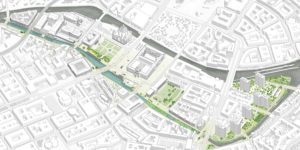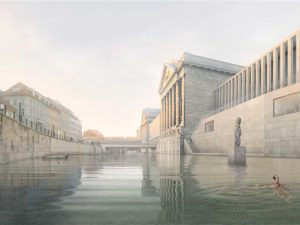An innovative project in central Berlin will transform a former shipping canal into an urban swimming area. The project, created by the non-profit Flussbad Berlin, plans to use a natural filtering system to clean the water, as well as a Wedeco UV system from Xylem.
The Spree canal and the river Spree flow around Museum Island, located in the heart of Berlin. The canal lost its importance for shipping around the turn of the 20th century, and in 1925 the last bathing establishment on the canal closed.

In 1997, two brothers – artists and architects Jan Edler and Tim Edler – developed an idea to restore the canal into an 835-meter (900-yard) bathing area. In 2012, they founded Flussbad Berlin, and in 2014 the organization received €4 million in funding from the Berlin and German governments.
Ensuring a safe level of water quality
Upstream from the swimming area, a reed bed and sub-surface sand will be put in place to naturally filter the water. If the water quality deteriorates – due to a sewer system overflow caused by heavy rain, or increased microbiological activity caused by high temperatures – Xylem’s Wedeco Spektron UV system will ensure that water quality is maintained.
“The aim of this project is to give people living in cities a better quality of life,” says Carlos Silva, sales representative at Xylem. To support the project, Xylem has supplied its UV system for the testing phase free of charge.
UV light provides environmentally friendly disinfection
A test phase of the project is currently underway. The UV system uses UV rays to clean the water and remove harmful microorganisms, viruses and bacteria. It complements the natural filter, which can provide only limited treatment.
UV light inactivates the ability of the cells within organisms to divide. The UV dose lies precisely within the range that prevents photoreactivation of the microorganisms, while keeping costs at a reasonable level.
“Electricity costs are negligible,” Silva says. “And a low-pressure UV system is much more appropriate than chemical processes using chlorine or chlorine oxide, because no harmful by-products are produced and no chemicals are used.”
A blueprint for the revitalization of other rivers and canals

The Berlin project shows that it is possible to create and restore inner-city swimming areas. With the right concept in place, natural waters can be kept clean at a low cost, providing opportunities for swimming and other water activities. For example, canals could even be used for wakeboarding or surfing, using artificially created waves.
The Flussbad Berlin swimming area is scheduled to be complete by 2025.

